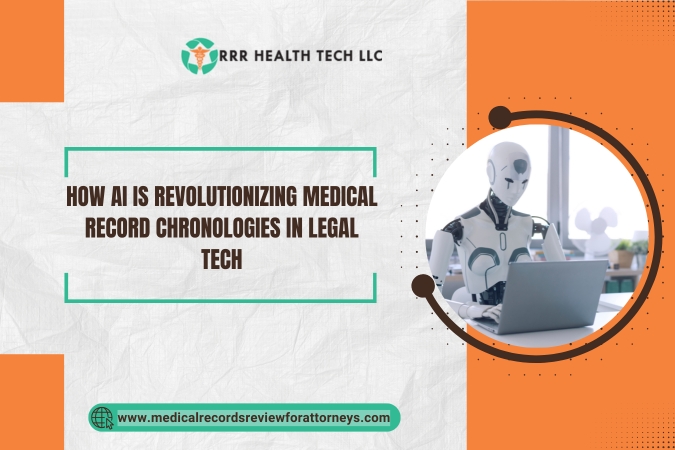
The incorporation of artificial intelligence in legal technology has changed how lawyers work with medical record chronologies. It is now quicker, more precise and streamlined. This article explores how artificial intelligence is improving medical record chronologies, how practitioners will benefit and how medical records review companies can support lawyers in the United States. In the high speed environment of legal operations, especially with medical malpractice and personal injury, the movement and management of medical records is critical. In the realm of legal practice, the transformation brought on by AI integration in the legacy practice of legal tech cuts across several areas.
Understanding Medical Record Chronologies
What is a Medical Record Chronology?
- Definition: A medical record chronology is a detailed timeline that outlines a patient’s medical history including medications and procedures.
- Importance: This chronology is essential for comprehending the events in a case, pointing the legal issues, and creating the right strategy.
Traditional Challenges in Creating Medical Record Chronologies
- Difficult Just to arrive At: As noted above, medical record chronologies are supposed to be prepared based on the clinical documents available and most times it is sifting through a pile of documents which is daunting.
- Manual Error: As this task is almost entirely manual, there is a chance for some errors which may prove to be rather costly in court cases.
The Transformative Role of artificial intelligence in Medical Record Chronologies
Automated Data Extraction
• Efficiency: The process of extracting relevant information from a large number of medical records becomes a lot less time consuming and easy to do with the aid of automated scribes and computer-generated notes as AI algorithms make use deep learning technologies and NLP.
• Focus on Strategy: Legal professionals can now automate tasks like scanning medical records for essential information, allowing them to dedicate their time to more important aspects of a case, such as analyzing it and coming up with strategies for winning it.
Enhanced Accuracy
• Consistency: Aiding in the extraction and structuring of data ensures that the chronology is accurate and detailed eliminates the human factor, whereby AI extracts data following certain set guidelines.
• Reliable Foundation: When used in legal arguments, such precision and accuracy decreases the chances of disputes concerning the factual contentions, laying a strong foundation.
Efficient Data Organization
• Coherent Formatting: Data, once retrieved, can, with the supervision of AI, be presented in a reasonably organized and chronological composition, accompanied with the use of deep learning to highlight additional pertinent elements and easy to read summaries.
• Quick Access: Professionals in law are able to find essential information which would help them win their case without sifting through large amounts of disarranged records.
Legal Practice Software
•A leather’s proffering that I was offered at a recent firm to help translate documents could benefit from the employment of artificial intelligence tools. AI could help integrate the plethora of language software systems I was tasked with using in translating legal papers and documents pulling data and working on them.
• AI would help revolutionize the legal space without the need to shift from their current infrastructures as this would allow the firm to incorporate that the various tools that AI provides.
Time and Cost Savings
• A fluent in a thousand languages operational efficiency would mean cost savings. Using AI could ensure better productivity by reducing operational costs alongside saving time that exceeds expectations.
• With better productivity comes happier clients, in the overly competitive world of law, AI could help firms build a strong client base with accelerated accuracy and speed.
Key Areas of AI Implementation in Legal Tech
- Writing Reports and Document Drafting
• Being able to break down a document quickly up to analyzing language artificial intelligence systems have the capabilities of categorizing and flagging information relevant to the topics and documents in question.
- Preparing Legal Advice
• Legal advice in a fraction of the time through the use of AI tools that sift through mountains of case law, legal texts and other records which would provide relevant help.
- Data Analytics
• AI smarter than humans and understands patterns better, data analysis is not a challenge, with the historical data AI can start strategizing for legal disputes, assisting the lawyers in the process.
- Preparation of Contracts
• Automating the reviewing, of contracts also highlights issues concerning compliance and aids legal professionals with key terms.
Chatbots and Virtual Assistants
• Client Engagement: In a bid to enhance client interaction, artificial intelligence based chatbots can answer basic questions and dispense legal guidance.
Litigation Support
• Trial Preparation: AU gadgets help lawyers in cataloguing evidences and obtaining insights of the case, thus facilitating better trial prep.
Challenges and Considerations in AI Implementation
Data Privacy and Security
• Sensitive Information: Working with vast volumes of sensitive information must be accompanied with stringent data privacy requirements and security protocols to secure client data.
Integration with Existing Systems
• Seamless Adoption: Careful integration should be done with the existing legal software for the AI to be deployed without any disturbance to the practice.
Training and Adaptation
• Skill Development: Investment in education and support has to be done as legal personnel need to be trained on the AI tools in order for them to be effective.
Case Studies: AI in Action
Case Study 1: Personal Injury Case
- Overview: Aspects of medical history supporting a personal injury claim that a lawyer is trying to recover on behalf of a client usually lie in different records which a physician has in their hand.
- Challenges: The Lawyer had challenges in sifting through thousands of pages to locate the specific documents the Lawyer was looking for.
- Solutions: Using these AI-enabled services for searching medical records greatly aided in the quick retrieval of pertinent information because the records had already been sorted and summarized.
Case Study 2: Medical Malpractice Case
- Overview: A law firm reached out to a researcher for the intensive scrutiny of medical documents related to a medical malpractice case with multiple physicians.
- Challenges: The number of documents was extensive and the firm had a hard time narrowing down on documents that were really important.
- Solutions: The firm hired an AI based medical records indexing service which offered a timeline and summary of the medical records while marking the important information.
Conclusion
Attorneys and physicians have found a new skill set with the integration of AI into medical record chronologies considering the amount of complexity that comes with medical-related case. With automatic data entry, increased precision and improved workflows that it provides, lawyers will be allowed to invest their time in what truly matters, constructing winning case strategies for their clients. In order to render quality service in the changing and advancing legal sector, attorneys must prepare to implement researched technologies in order to advance their position.


